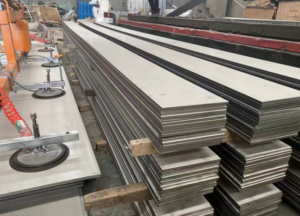Spring steel plays an important role in industrial fields such as engineering machinery, automobile manufacturing, and instrumentation due to its excellent physical properties. In the manufacturing process of spring steel, cold working and hot working of spring steel are the two main processing methods, which have a significant impact on the improvement of spring steel performance and quality.

Cold working and hot working of spring steel:
Cold working technology is to process spring steel at room temperature, including but not limited to rolling, bending and stretching processes. This processing method can improve the hardness and strength by changing the internal microstructure of the material, thereby enhancing the elasticity and fatigue resistance of spring steel. At the same time, cold working is particularly suitable for the production of spring components with complex shapes due to the flexibility and cost-effectiveness of the process and is not limited by steel precision, size, shape, etc.
The opposite of cold working is hot working, which is processed under high temperature conditions, such as hot rolling and forging. Thermal processing improves the plasticity of the material by heating it to a certain temperature, thereby improving the processing performance and the mechanical properties of the material, such as strength and toughness. Thermal processing helps reduce internal defects in the material, such as inclusions and bubbles, resulting in high-quality steel. Forging helps to improve the fiber structure of the material and improve its physical properties.
In practical applications, the choice of cold processing or hot processing usually depends on the specific requirements of the product. If there are high requirements for spring dimensional accuracy and surface finish, cold processing may be more suitable. For large springs or situations where the internal quality of the material is required, thermal processing is more suitable. In some special cases, in order to take full advantage of the advantages of both processing methods, a hybrid processing strategy may be adopted.
It is worth mentioning that whether cold working or hot working is used, the process parameters must be strictly controlled to ensure that the spring steel can achieve the expected performance. Temperature control, deformation degree, cooling rate and other factors during processing will have an important impact on the final performance of the material. In addition, subsequent processes such as heat treatment are closely linked to processing methods and can also improve the performance of spring steel.
In summary, cold working and hot working of spring steel are critical steps in the manufacturing process, and each has unique advantages. Through the reasonable selection and application of these two processing methods, high-quality spring products that meet different engineering needs can be produced, providing solid and reliable support for applications in various fields.
Conclusion
Thank you for reading our article and we hope it can help you to have a better understanding of the cold working and hot working of spring steel. If you are looking for spring steel suppliers and manufacturers online now, we would advise you to visit Huaxia Steel.
As a leading supplier of spring steel from Shanghai China, Huaxia Steel offers customers high-quality spring steel products at a very competitive price.




